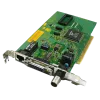10BASE5 (also known as thicknet) is the original "full spec" variant of Ethernet cable, using RG-8 (Radio Grade - 8) coaxial cable. This is a stiff, 0.405 inch diameter cable with an impedance of 50 ohms, a solid center conductor, a solid insulating filler, a shielding braid, and an outer jacket. The outer sheath is often yellow-to-orange polyvinyl chloride so it frequently is just called "yellow cable" or sometimes humorously "frozen yellow garden hose". The name 10BASE5 is derived from several characteristics of the physical medium. The 10 refers to its transmission speed of 10 Mbit/s. The BASE is short for baseband signalling as opposed to broadband, and the 5 stands for the maximum segment length of 500 metres.
10BASE5 cable is designed to allow transceivers to be added while existing connections are live. This is achieved using a vampire tap - a device which (with sufficient practice) clamps onto the cable, forcing a spike to pierce through the outer shielding to contact the inner conductor while other spikes bite into the outer conductor. This is often built into the transceiver and a more flexible multi-wire cable carries the connection between the transceiver and the node.
The maximum practical number of nodes that can be connected to a 10BASE5 segment is limited to 100 and transceivers may be installed only at 2.5 metre intervals. This distance roughly corresponds to the wavelength of the signal. These suitable points are marked on the cable with black bands.
The transceivers connect to nodes using an interface called Attachment Unit Interface (AUI). This interface uses a 15 pin, two row D-style connector but with clips instead of the more normal screws for cable restraint.


